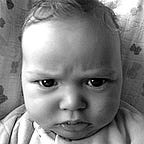Synergy Coefficient
I use naive math to explain teamwork
Alas, people are not numbers. Managers can’t solve too many problems in Excel. Nevertheless, thinking about teamwork in terms of variables and equations has always been entertaining for me and often also helpful.
Of course, my naive teamwork math isn’t exact science. It doesn’t yield complete answers or lead to perfectly replicable management practices. But what it does do is help me think. It identifies some important patterns I can then pay better attention to. This is why I often draw charts on pieces of paper or juggle numbers in spreadsheets: to understand my team better.
As an example, let’s consider something I believe is one of the most important variables of teamwork: synergy.
What is Synergy?
Some people may have mediocre results when they work alone. But put them in a team with the right person and all of a sudden their results explode. However, if you put them in a team with the wrong person, their results may disappoint. I noticed this pattern as I observed developers’ performance working alone and then in different groups. Come to think of it, I probably noticed it first as a kid, playing basketball.
When people work together, their performance is not equal to the sum of their individual results. Most of the time — and especially in a creative industry such as software development — the performance of a team is either much better or much worse than the sum. This effect is called “synergy” and we’ve known about it for ages.
If you pay close attention to synergy, theoretically, you can improve performance by being careful of who you put together in a team (i.e., when you hire or plan work).
While trying to apply this theory in a spreadsheet, I came up with something I now call “the synergy coefficient”.
What is Synergy Coefficient?
I created a list of all possible pairs in my team. This means that the list contained n(n-1)/2 pairs, where n is the number of people in the team. For each pair, I tried to objectively score their synergy with a number (> 1 for positive synergy and < 1 for negative, while 1 corresponds with the synergy of two people who don’t work together). This number was then the pair’s synergy coefficient, which means that the sum of their individual performances is multiplied by that. So the performance of Susan and Peter working together could be explained as:
Performance(Susan, Peter) = (Performance(Susan) + Performance(Peter)) × Synergy(Susan, Peter)
I then extended this to the entire team and assumed the synergy coefficient of the team would be the product of synergy coefficients of all the pairs:
Synergy(Susan, Peter, Bob) = Synergy(Susan, Peter) × Synergy(Susan, Bob) × Synergy(Peter, Bob)
What this theory could mean in practice is that a team of people who influence each other’s performance in positive ways will perform better than a team of people who get very little out of their collaboration or, even worse, have negative influence on each other’s performance. This would explain why some teams are able to produce orders of magnitude more value than other teams with seemingly similar resources.
Can we accurately measure synergy? Probably not. But it is helpful enough to approximate it based on your objective observation.
Steer Clear of Bias
The mistake I made initially was to trust my personal biases and assume that positive relationships (e.g., friendship, loyalty, common interests, etc.) translate to positive influence on synergy, while negative relationships (e.g., envy, rivalry, fear) translate to negative. They often do, but not always. So I observed the performance of different pairs working together and then tried to reverse-engineer the influences that led to either positive or negative effects. While things like friendship may indeed help, I also witnessed negative relationships, such as rivalry, having the same (or even greater!) positive effect. The opposite can also be true.
Team Size and Diminishing Returns
We could jump to a conclusion that a team’s performance can be constantly improved by continuously adding more people with positive synergy coefficients. I don’t think it’s that simple for two main reasons:
- adding more team members increases the organisational overhead, which harms performance (e.g., proponents of Agile usually advise against having more than 9 team members) and
- with the size of the team increasing, it also becomes increasingly tricky to hire new members that would pair well with each existing member (i.e. the likelihood of hiring a bad fit is increasing).
A Bad Fit
The Synergy Coefficient table turned out to be particularly useful for hiring decisions. After the interviews, I would insert the candidate in the table and try to estimate how well they would pair with my existing coworkers.
Even a single person that doesn’t pair well with a few other team members can significantly harm your team’s overall synergy (e.g., imagine Synergy(Susan, Bob) = 0.1). This would explain why the brilliant jerk, who has notoriously bad synergy coefficients with most coworkers, wreaks havoc on overall performance, even if his individual performance is excellent.
Importance of Awareness
Synergy Coefficient is a mental exercise. I find it useful because it forces me to be objective about the personalities in my team. This means that I need to:
- get to know my coworkers, as well as relationships between them and
- pay close attention to how they work and perform in different situations.
I’m probably not qualified to give you advice on how to improve perception and awareness, but I’m sure it can be done. You don’t need to be an extrovert, but it helps to have a genuine interest in humans and their relationships. In fact, I can’t think of a better obsession to have as a manager.
